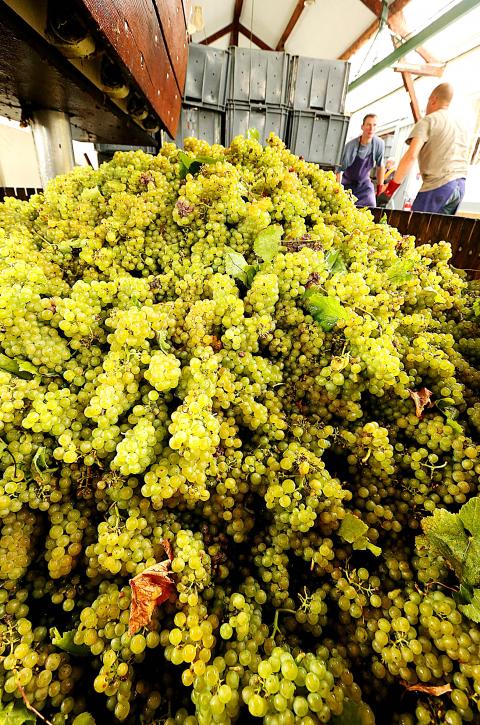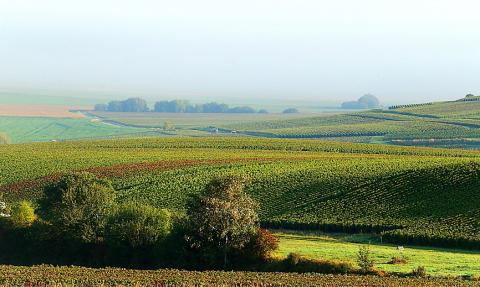If ever there was a place destined to produce a cheeky tipple, it has to be the village of Bouzy in the champagne country of northern France.
Yes, the village’s name really is pronounced “boozy” and that is not the only thing that stands out about this charming little corner of the wine world.
All around the town stretch vineyards that produce the grapes to make the world’s most prestigious sparkling wine. For as far as the eye can see, bubbles are the business, and a lucrative one at that.

Photo: AFP
However, Bouzy has another string to its bow, thanks to a group of dedicated producers who have opted to maintain — albeit largely as a sideline — a centuries-old tradition of producing still red wine from pinot noir vines planted close to the northern limit of where the notoriously fickle varietal will ripen fully.
“We are like the little Gaulois village in the Asterix stories,” local vigneron Jean-Rene Brice said. “Instead of holding out against the Romans, we are holding out for red wine production, whilst all around everyone is making champagne.”
Brice’s family property has eight hectares of vines situated above the village on land that is eligible to provide red grapes for the production of the very best champagnes, Grand Cru, most of which are assembled from a mixture of black pinot noir and pinot meunier grapes and chardonnay white grapes.

Photo: AFP
Despite the high price that grapes destined for bottles of bubbly can command, Brice keeps one-eighth of his land dedicated to the production of Bouzy Rouge, ensuring the maintenance of a tradition his family have nurtured since the 17th century.
“This wine was being served at royal coronations and savored at the table of Louis XIV long before champagne acquired its worldwide fame,” he said, referring to the many French kings who were once crowned in the cathedral at Reims, the capital of the Champagne region.
The vines used to produce the ruby-colored nectar are the oldest on Brice’s plot and also benefit from being in the most optimal spot — halfway up a south-facing slope — to maximize their exposure to the sun’s rays, which can be rare some years.
“We leave the grapes to ripen for as long as we possibly can before picking them,” Brice said. “Above all, we are looking for fruit and power, and lower acidity than is required for grapes destined for champagne production.”
In this part of the world, just 160km from France’s border with Belgium, the winemaker’s nightmare is harvest rain, which can drastically dilute the flavor of the grapes, as well as the sugar required to ensure the final product has the body that producers are aiming for.
An Indian summer this year kept Brice and his colleagues happy, with the final batches of grapes landing in their wineries in the second week of this month.
Only the plumpest, ripest bunches get through a rigorous hand-picking selection process and, to avoid too many green tannins in the final blend, the stems are removed mechanically before fermentation.
After 10 days in steel, the young wine is transferred to oak barrels for a time that varies by producer before being bottled and stored for at least three years prior to release for drinking.
“It is a wine that can be appreciated young, but a Bouzy from a good year can also make an excellent keeping wine,” Brice said.
Overall, only one in 10 of Bouzy’s 380 hectares of Grand Cru terroir are reserved for the production of still wine — some producers make a white, as well as a red.
The rewards are not as great as those from making champagne, but, with only 45,000 bottles of Bouzy Rouge produced in a good year, producers can count on a rarity factor and that fabulous name to help secure a decent price for their output. The reds typically retail in France for about 20 euros (US$27) a bottle.
Bouzy is the best-known, but by no means the only, Champagne village to produce still wine. Upmarket brand Bollinger notably makes a celebrated boutique wine, La Cote aux enfants, from a one-hectare parcel of land in Ay.
In all, about 100,000 bottles of still wine are produced each year in the area authorized for champagne production — a mere splash in the lake of the 308 million bottles of fizz that the region turned out last year.
The bulk of the still wine produced in Bouzy is sold as is, but some also goes into the manufacture of pink champagne, which is currently enjoying a mini-boom in popularity and now accounts for 10 percent of all champagne sales.
It is the only French rose wine allowed to be made by blending red and white wines.

With an approval rating of just two percent, Peruvian President Dina Boluarte might be the world’s most unpopular leader, according to pollsters. Protests greeted her rise to power 29 months ago, and have marked her entire term — joined by assorted scandals, investigations, controversies and a surge in gang violence. The 63-year-old is the target of a dozen probes, including for her alleged failure to declare gifts of luxury jewels and watches, a scandal inevitably dubbed “Rolexgate.” She is also under the microscope for a two-week undeclared absence for nose surgery — which she insists was medical, not cosmetic — and is

CAUTIOUS RECOVERY: While the manufacturing sector returned to growth amid the US-China trade truce, firms remain wary as uncertainty clouds the outlook, the CIER said The local manufacturing sector returned to expansion last month, as the official purchasing managers’ index (PMI) rose 2.1 points to 51.0, driven by a temporary easing in US-China trade tensions, the Chung-Hua Institution for Economic Research (CIER, 中華經濟研究院) said yesterday. The PMI gauges the health of the manufacturing industry, with readings above 50 indicating expansion and those below 50 signaling contraction. “Firms are not as pessimistic as they were in April, but they remain far from optimistic,” CIER president Lien Hsien-ming (連賢明) said at a news conference. The full impact of US tariff decisions is unlikely to become clear until later this month

GROWING CONCERN: Some senior Trump administration officials opposed the UAE expansion over fears that another TSMC project could jeopardize its US investment Taiwan Semiconductor Manufacturing Co (TSMC, 台積電) is evaluating building an advanced production facility in the United Arab Emirates (UAE) and has discussed the possibility with officials in US President Donald Trump’s administration, people familiar with the matter said, in a potentially major bet on the Middle East that would only come to fruition with Washington’s approval. The company has had multiple meetings in the past few months with US Special Envoy to the Middle East Steve Witkoff and officials from MGX, an influential investment vehicle overseen by the UAE president’s brother, the people said. The conversations are a continuation of talks that

CHIP DUTIES: TSMC said it voiced its concerns to Washington about tariffs, telling the US commerce department that it wants ‘fair treatment’ to protect its competitiveness Taiwan Semiconductor Manufacturing Co (TSMC, 台積電) yesterday reiterated robust business prospects for this year as strong artificial intelligence (AI) chip demand from Nvidia Corp and other customers would absorb the impacts of US tariffs. “The impact of tariffs would be indirect, as the custom tax is the importers’ responsibility, not the exporters,” TSMC chairman and chief executive officer C.C. Wei (魏哲家) said at the chipmaker’s annual shareholders’ meeting in Hsinchu City. TSMC’s business could be affected if people become reluctant to buy electronics due to inflated prices, Wei said. In addition, the chipmaker has voiced its concern to the US Department of Commerce